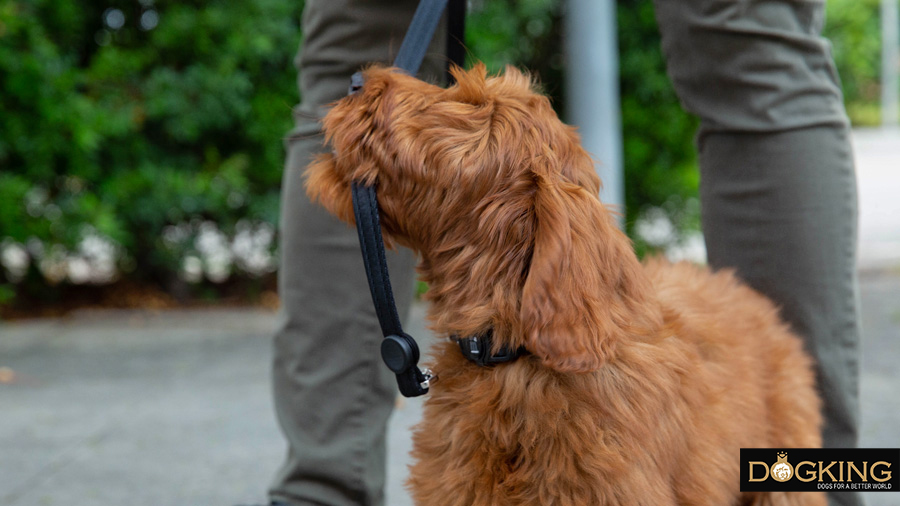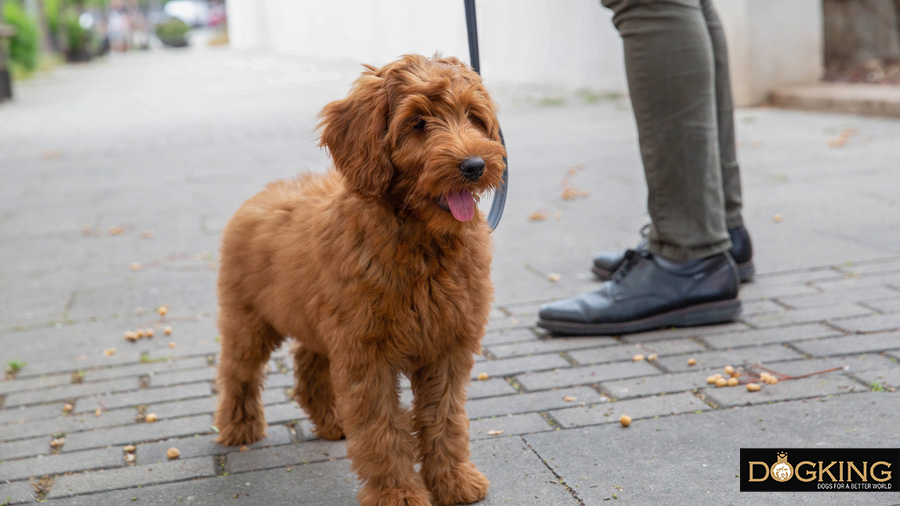Was kann man tun, damit mein Hund nicht mehr an der Leine kaut?
Wir zeigen Ihnen, wie Sie dieses unangenehme Verhalten Ihres Haustieres ein Ende setzen können

WAS PASSIERT, WENN MEIN HUND IN DIE LEINE BEIßT?
Ungefähre Lesezeit: 9 minuten
Wir wissen, wie frustrierend es sein kann, wenn man mit seinem Hund spazieren geht und er nicht ständig aufhört, an der Leine zu kauen und damit zu spielen. Diese Verhaltensweise Ihres Haustiers ist sehr störend, denn sie macht den Spaziergang zu einem ständigen Kampf und es besteht die Gefahr, dass die Leine reißt und das Tier entkommt, sich am Maul verletzt oder ein Stück Stoff verschluckt. Normalerweise beginnt dieses Verhalten im Welpenalter als Spiel, aber es ist wichtig, es so schnell wie möglich zu korrigieren, damit es nicht zur Gewohnheit des erwachsenen Hundes wird.

Inhaltsverzeichnis
1- Warum beißt mein Hund beim Spaziergang in die Leine?
2- Wie kann ich meinen Hund davon abhalten, in die Leine zu beißen?
3- Welche Materialien sind am besten geeignet?
Warum kaut mein Hund an der Leine, wenn ich mit ihm spazieren gehe?
- Mangelnde Stimulation: Wenn Ihr Hund sich auf Spaziergängen langweilt oder unmotiviert ist, kaut er vielleicht auf der Leine herum, um sich zu bespaßen. Versuchen Sie, mit ihm an verschiedene Orte zu gehen, und nehmen Sie einige seiner Lieblingsspielzeuge mit, damit die Spaziergänge für Ihren Hund wirklich bereichernd sind.
- Zahnschmerzen: Sowohl bei Welpen als auch bei erwachsenen Hunden kann das Kauen auf der Leine wegen Zahnschmerzen sein, obwohl Sie in diesem Fall feststellen werden, dass Ihr Hund auch auf andere Dinge beißt.
- Nervosität: Fühlt sich Ihr Hund auf einem Spaziergang gestresst, sei es wegen zu intensiver äußerer Reize oder weil er nicht richtig sozialisiert wurde, zeigt er seine Angst wahrscheinlich durch das Kauen auf seiner Leine. Es ist wichtig, Hunde von klein auf an alle Arten von Spaziergängen zu gewöhnen und die Vielfalt und Intensität der Reize schrittweise zu steigern.
- Unbehagen: Ihr Hund bittet Sie um Freiheit, indem er in die Leine beißt. In der Stadt besteht in der Regel eine Leinenpflicht, Sie sollten Ihre Hunde jedoch regelmäßig mit aufs Land oder in Gehege nehmen, wo sie frei herumlaufen dürfen. So kann er sich frei bewegen und fühlt sich viel glücklicher und zufriedener.
- Gewohnheit: Wenn das Verhalten als Welpe entstanden ist und das Tier nicht korrigiert oder gar bestärkt wurde (mit liebevollen Worten, Streicheleinheiten oder sogar Schimpfen), ist es logisch, dass es auch als Erwachsener weiterhin in die Leine beißt. Dies kann auch passieren, wenn Sie mit Ihrem Haustier Tauziehen spielen. In diesen Fällen weiß das Tier nicht, dass die Leine nicht zum Spielen gedacht ist, so dass es korrigiert und erzogen werden muss.

Wie kann ich verhindern,dass mein Hund in die Leine beißt?
Was auch immer der Grund sein mag: Machen Sie sich keine Sorgen, wenn Ihr Hund ständig in die Leine beißt und das Gehen zu einer Reihe von Ziehens- und Schiebebewegungen wird, die schlussendlich zu einer stressigen Zeit für Sie beide werden. Von diesem Verhalten wegzukommen ist möglich, erfordert jedoch viel Geduld, wenn Ihr Hund bereits erwachsen ist. Idealerweise beginnen Sie mit dieser Schulung, während das Tier noch ein Welpe ist. Schauen wir uns einige Regeln an, um Ihren Hund davon abzuhalten, in die Leine zu beißen.
Bringen Sie ihm bei, die Leine zu tragen
Wenn Ihr Hund ein Welpe ist, bringen Sie ihm rechtzeitig bei, die Leine zu akzeptieren und sie ruhig und natürlich zu tragen. Bevor Sie nach draußen gehen, beginnen Sie zu Hause mit dem Üben, indem Sie Ihr Haustier die Leine untersuchen und daran schnüffeln lassen. Dann legen Sie es kurz an und belohnen es mit Streicheleinheiten oder Snacks, aber bewegen Sie sich nicht, sondern lassen Sie die Leine einfach auf dem Boden liegen. Mit dieser Übung bringen Sie Ihren Hund dazu, die Leine als etwas Positives zu sehen.
Versuchen Sie nach mehrmaligem Wiederholen, die Leine zu nehmen und den Welpen durch das Haus zu führen. Wenn er ruhig neben Ihnen hergeht, belohnen Sie ihn mit einem Leckerli, wenn er jedoch weggeht, bleiben Sie stehen und rufen Sie ihn an. Wenn er zu Ihnen kommt, belohnen Sie ihn erneut mit Snacks oder Streicheleinheiten. Nach und nach können Sie einige Elemente in Ihren Weg einführen, die ihn ablenken können, z. B. Spielzeug oder andere Personen. Auf diese Weise messen Sie die Konzentrationsfähigkeit Ihres Hundes und er wird nach und nach Fortschritte in diesem Lernprozess machen. Sobald der Hund alle erforderlichen Impfungen erhalten hat, beginnen Sie beim Rausgehen an ruhigen Orten ohne allzu große Reize.
Lenken Sie ihn ab
Dieser Ratschlag gilt unabhängig vom Alter des Hundes. Wenn Ihr Haustier während des Spaziergangs versucht, mit der Leine zu spielen oder in sie zu beißen, halten Sie an und bitten Sie es, es loszulassen, wenn Sie dieses Signal trainiert haben. Sie können ihn ermutigen, indem Sie ihm eines seiner Spielzeuge anbieten, was seine Aufmerksamkeit ablenkt und ihn dazu bringt, die Leine loszulassen. Wenn er anfängt, damit zu spielen, belohnen Sie ihn, damit er versteht, dass es tatsächlich Spaß macht und angenehm ist, mit diesem Objekt zu spielen.
Schaffen Sie eine Spielroutine
Wenn Ihr Hund die Leine als Spielzeug sieht, sollten Sie versuchen, jeden Tag zur gleichen Zeit eine Spielzeit einzuplanen. Die Festlegung eines Zeitplans kann Ihrem Hund helfen, zu verstehen, dass er nur zu dieser Zeit Spaß am Spielen haben kann und nicht zu einem anderen Zeit. Wenn diese Spielzeit kurz vor dem Spaziergang stattfindet, ist Ihr Hund wahrscheinlich schon ziemlich aufgeregt und genießt den Ausflug auf eine ruhigere und konzentriertere Weise. Somit ist es weniger wahrscheinlich, dass er den Drang verspürt, an der Leine herumzufummeln.
Korrigieren Sie sein Verhalten
Wenn Sie möchten, dass Ihr Hund die Leine loslässt, schimpfen Sie nicht mit ihm, da er dies als Verstärkung auffassen könnte. Wenn wir uns über unser Haustier ärgern, schenken wir ihm Aufmerksamkeit, die er möglicherweise falsch interpretiert. In diesem Fall ist es am besten, den Spaziergang ganz zu unterbrechen, dem Tier sogar den Rücken zuzuwenden und es einige Augenblicke lang zu ignorieren. Wenn er die Leine loslässt, können wir den Spaziergang fortsetzen, aber wenn er weiterhin in die Leine beißt, wiederholen wir die Übung, um dem Tier zu zeigen, dass der Spaß am Spaziergang und unsere Aufmerksamkeit aufhören, wenn er dieses Verhalten zeigt. Eine andere Idee ist, die Leine je nach Verhalten des Hundes spielerisch zu verkürzen oder zu lockern. Wenn Ihr Tier in die Leine beißt, nehmen Sie sie in die Hand, um sie zu straffen und den Hund näher an Ihre Seite zu bringen. Halten Sie den Spaziergang an und warten Sie einige Augenblicke. Wenn Ihr Tier aufhört zu beißen, können Sie die Leine loslassen, um das Verhalten zu verstärken.
Ziehen Sie nicht an der Leine
Wenn Ihr Hund während des Spaziergangs auf der Leine kaut, versuchen Sie, nicht an der Leine zu ziehen oder sie zu verdrehen. Das Ziehen an der Leine kann Ihrem Hund viel Spaß machen, so dass Sie sein Verhalten und die Vorstellung des Tieres vom Spiel an der Leine verstärken. Auch wenn das Ziehen nicht sehr stark ist, können Sie ihn ungewollt verletzen. Empfehlenswert ist es, einige der oben genannten Übungen auszuprobieren, vergessen Sie das Ziehen an der Leine oder das Schimpfen mit dem Hund.
Beratung durch einen Ethologen oder Trainer
Obwohl es sehr häufig vorkommt, dass Ihr Hund zum Spielen an der Leine kaut, gibt es auch schwerwiegendere Ursachen, die dieses Verhalten erklären könnten. Hinter dieser scheinbar harmlosen Manie könnte sich eine Verhaltensstörung verbergen, wie z. B. Angstzustände des Hundes oder ein Zahnproblem oder Nährstoffmangel. Es ist zwar nicht das üblichste, aber es schadet nie, auf Nummer sicher zu gehen und den Tierarzt für eine Routineuntersuchung aufzusuchen. In Fällen, in denen der Hund übermäßig auf die Leine fixiert ist und nicht auf positive Verstärkung reagiert, empfehlen wir eine professionelle Beratung durch einen Verhaltensforscher oder Trainer
Welche Materialien sind am besten geeignet?
Während Sie Ihrem Hund beibringen, nicht mehr auf der Leine zu kauen, empfehlen wir Ihnen, eine möglichst feste Leine zu verwenden. Nylon oder Leder sind die am besten geeigneten Materialien, unabhängig davon, ob Ihr Tier auf der Leine kaut oder nicht. Diese Stoffe sind von hoher Qualität und sehr robust, so dass die Leine nicht so leicht reißen kann.
Die Erziehung unseres Hundes zum richtigen Spazierengehen ist von grundlegender Bedeutung, damit er alle Vorteile genießen kann. Bei Spaziergängen erkunden Hunde ihre Umgebung, knüpfen soziale Kontakte zu anderen Artgenossen und Menschen und werden kognitiv stimuliert. Wenn Ihr Hund nicht aufhört, an der Leine zu kauen, kann er nicht in vollem Umfang von dieser notwendigen und positiven Routine profitieren. Denken Sie daran, dieses Verhalten umzuleiten, sobald Sie es bemerken, damit Sie weiterhin angenehme Spaziergänge mit Ihrem pelzigen Freund genießen können.